Manchester Corporation Tramways
History
Manchester Corporation became the owner of an operational horse-drawn tramway on the 17th May 1877, when the newly built, standard-gauge line between Pendleton and Higher Broughton (in Salford), via Albert Bridge and Deansgate (in Manchester), was opened. The tramway was branded as 'Manchester and Salford Tramways' with each corporation owning the tracks in their respective municipalities.
Operation of the line was leased to Messrs Busby and Turton, two well-known figures in the tramway world who, without the knowledge of the corporations, transferred the lease to the Manchester Carriage Company. The corporations took an extremely dim view of this, so much so that they refused to formally recognise the MCCo as the lessee, even though it ran all the services! Busby and Turton had never had any intention of operating the tramway themselves, and this move essentially set the tone for future relations, particularly with Salford Corporation, as all their planned lines, unlike those of Manchester Corporation, had also been included in the original lease. The dispute over the lease even continued after the 2nd August 1880, when the MCCo was merged with the Manchester Suburban Tramways Company (this was a vehicle used by Busby, Turton and the MCCo to secure tramway powers) to form the Manchester Carriage and Tramways Company. The dispute was eventually resolved on the 25th June 1890, a staggering 13 years after matters first came to a head.
At its maximum, Manchester's horse-drawn tramway system totalled around 25 miles. These lines effectively formed the core of the MC&TCo's extensive network, and were not operated in isolation, so can only really be understood in that wider context. From the city centre, the MC&TCo operated lines which ran: northwards to Cheetham Hill and Barnes Green; northeastwards to Oldham and Waterhead; eastwards to Clayton, Openshaw, Ashton-under-Lyne and Stalybridge; southeastwards to Denton and Stockport; southwards to West Didsbury, Moss Side and Whalley Range; southwestwards to Stretford; westwards to Eccles and Peel Green, and northwestwards to Swinton, Pendlebury, Lower Broughton and Broughton Park. Manchester built and owned the tracks within its boundary, but as the city boundaries expanded, it inevitably encompassed tracks that were either built by Local Boards or by the company itself.
By 1896, both Manchester and Salford Corporations had decided to convert their respective tracks to electric traction, and with this in mind, the MC&TCo's early Manchester and Salford leases were extended such that they all expired on the same day (the 27th April 1901). Although the company attempted to obtain powers to convert the system to electric traction, there was concerted opposition from the many local authorities through which its lines ran, and it was clear to all that the MC&TCo's days were numbered. In early 1898, in a rare and short-lived atmosphere of municipal planning and cooperation, the local authorities came together to discuss and agree which of them would operate new electric tramway services (Ashton-under-Lyne, Manchester, Oldham, Salford, Stalybridge, and Stockport) and which would rely upon those authorities for a service (Audenshaw, Denton, Droylsden, Eccles, Failsworth, Gorton, Heaton Norris, Levenshulme, Moss Side, Stretford, Swinton, Pendlebury and Withington).
Detailed planning for electric operation began late in 1898, so preparations were well advanced when Manchester Corporation took control of the horse tramway lines on the 1st May 1901; unlike Salford Corporation, Manchester had reached agreement with the MC&TCo for the company to continue horse-drawn operations during conversion to overhead electric traction, up until the 31st March 1903. The first electric route opened on the 7th June 1901, with further routes following in quick succession during 1902 and 1903.
The corporation was, however, also destined to become a horse tram operator for a short period, when it agreed to continue horse tramway services in Ashton and Stalybridge after the respective corporations had taken possession of the horse tramway lines in their municipal boundaries, the MC&TCo having run its last service on the 31st March 1903. The two corporations set about converting the horse lines to electric traction, the last horse tram running over former MC&TCo metals on the 14th October 1903 (operated by Manchester Corporation).
The system was well run and well maintained, contributing very significant sums to the relief of rates, as well as renewals. Like many systems, however, it emerged from the depredations of the Great War with a huge maintenance and renewals backlog, into a world of vastly increased operating costs (manpower and materials) and economic difficulties. The corporation continued to invest in the tramways, though most of the extensions which had been planned prior to the war were never built. Significant expansion of the network did, however, come in 1921 when the corporation took over operation of the former Oldham, Ashton and Hyde Electric Tramways Company lines within Denton and Audenshaw, again in 1925 with agreement to operate Middleton Corporation's share of the former Middleton Electric Traction Company, and lastly in 1928 when it built a new line from Middleton to Hopwood.
Although the corporation had been a bus operator since 1906, significant expansion did not really begin until the late 1920s, primarily in response to the unregulated bus competition that was significantly impacting the tramway's revenue. Joint bus services were also introduced to combat this, and though largely successful, they inevitably took passengers from the tramcars. The name of the department was changed on the the 1st November 1929 — to Manchester Corporation Transport — to reflect the increasing reliance on bus services.
A change in management in 1929 brought about a change in policy, whereby buses were substituted for tramways whenever expensive track renewals were needed; the first of these — from Cheetham Hill Road to Stretford Road — taking place during April 1930. Further abandonments took place in the 1930s, most lines being replaced by buses, though some, such as the service to Ashton-under-Lyne were replaced by trolleybuses (on the 1st March 1938). A detailed plan for full abandonment of the tramways was endorsed by the City Council on the 8th February 1939, minds undoubtedly focused by the £10,000 per month losses that tramway operations were incurring. The programme of closures would probably have resulted in the last trams running in 1941, but as with many other systems, the exigencies of war — restrictions on bus fuel and ordering new vehicles (of any description) — soon led to a hiatus. Abandonment restarted in 1945, with the last MCT trams running on the 10th January 1949.
At its height, Manchester Corporation operated 119.23 miles of tramway, 87.98 miles owned by the corporation, 1.72 miles by Heywood Corporation, 9.01 miles by Middleton Corporation, 1.67 miles by Failsworth Urban District Council, 1.14 miles by Droylsden UDC, 4.86 miles by Audenshaw UDC, 4.61 miles by Denton UDC, 7.42 miles by Stretford UDC, 1.01 miles by Sale UDC, 2.18 miles by Ashton upon Mersey UDC, 1.8 miles by Altrincham UDC and 2.2 miles by the Trafford Park Estates Company.
The system comprised lines: northwards to Prestwich, Heaton Park and Middleton; northeastwards to New Moston and Hollinwood; eastwards to Droylsden, Audenshaw, Denton and Haughton Green; southeastwards to Heaton Norris, southwards to East Didsbury; southwestwards to West Didsbury, Chorlton, Sale and Altrincham; and westwards to Trafford Park and Salford.
Manchester tracks met those of Stockport Corporation (at Heaton Norris and North Reddish), Stalybridge, Hyde, Mossley and Dukinfield Joint Tramways (at Broomstair Bridge, Denton), Oldham Corporation Tramways (at Hollinwood), Rochdale Corporation Tramways (at Sudden, via Middleton Corporation-owned tracks), Heywood Corporation (at Hopwood, again via Middleton Corporation-owned tracks), and Salford Corporation Tramways (at several points). At various times, through-running agreements were put in place which saw MCT cars reach Ashton, Hazel Grove, Heywood, Hyde, Oldham, Rochdale, Salford and Swinton, whilst cars from Bury, Oldham, Rochdale, Salford and Stockport Corporation Tramways reached Manchester, as well as those of the South Lancashire Tramways Company and the SHM&DJT.
Uniforms
Manchester Corporation Tramways is extremely well-represented photographically, so it is possible to describe the gradual change in the uniform and insignia, over the years, with a high degree of confidence.
In the first four years or so of operation, motormen (known as 'drivers' in Manchester) were issued with double-breasted jackets with four pairs of buttons (presumably brass — see link) and lapels; the jacket collars carried an employee number on the bearer's left-hand side (in individual brass numerals) and a brass, underlined script-lettering grade badge — 'Driver' — on the other side. The badge was of one-piece construction, underlined, and with the tail cut off obliquely from top left to bottom right (see photo below); this pattern of badge appears to have been used by only a very small number of operators, namely: Manchester Corporation Tramways, and the nearby systems of Stalybridge, Mossley, Hyde and Dukinfield Tramways, and the South Lancashire Tramways Company; the latter two presumably followed Manchester's lead in this regard. Conductors (known as 'guards' in Manchester) wore single-breasted jackets with five buttons and stand-up collars. Like the motormen, an employee number was worn on the bearer's left-hand collar and a grade badge — 'Guard' — on the right-hand side. Both grades were also issued with drooping-peak caps; these had a steeply inclined glossy peak and bore a large brass cap badge comprising the municipal arms above a ribbon bearing the full system title: 'MANCHESTER CORPORATION TRAMWAYS'.
Around 1903, a change was made to the style of the motormen's tunics, as well as to the headwear of all tramcar staff. Motormen were now issued with double-breasted, lancer-style tunics with five pairs of buttons and stand-up collars; the latter continued to bear the same insignia as previously. Having said that, several photographs have survived which show motormen wearing the same style of single-breasted jackets issued to conductors, so the change-over probably took place as and when individuals were due to be issued with replacement garments. The caps were initially a soft-topped peaked type, however, these do not appear to have lasted long — perhaps only two or three years, before being replaced by a smarter style of peaked cap with a tensioned crown (top). Both styles of cap carried the same cap badges as the earlier drooping-peak caps. At some point, probably towards the end of the Great War, epaulettes were added to both the jackets and the greatcoats, though photographs have also survived from the same period which show jackets without epaulettes.
A change was made to a more modern style of uniform some time around 1930. Jackets for all tramcar staff were now double-breasted with four pairs of closely spaced buttons, two waist pockets, lapels and epaulettes (with button fastenings); the latter, like the greatcoats (see later), appear to have carried an employee number in individual metal numerals on the left-hand side, and a grade badge on the right-hand side. The uniform material was blue serge with red piping, and probably carried brass 'Manchester Corporation Transport' insignia (cap badges and buttons), a switch later being made to chrome 'Manchester Corporation Transport' insignia, probably in the 1940's.
Given the famous Mancunian weather, staff were frequently to be seen in long, double-breasted greatcoats; these had five pairs of buttons and high, fold-over collars, which usually carried the same insignia as the tunics that were worn underneath. At some point, the design of the greatcoats was subtly changed to include epaulettes (with button fastenings), probably at the same time as the same embellishment was applied to the jackets. Whilst the epaulettes bore an employee number, and probably a grade badge (left and right, respectively), the collars appear to have been left plain, i.e., without badges of any kind. Epaulettes also began to make an appearance on the conductors' jackets, very possibly at the same time as they were introduced on the greatcoats.
Manchester, along with Salford, was a great employer of trolley boys, young lads who assisted the conductor on the larger double-deck trams by directing passengers and, as the name implies, moving the trolley boom. The position lasted until 1933. In the early years, these boys were issued with single-breasted jacket with lapels; they bore an employee number on the bearer's left-hand side, with the other side left plain, i.e., no grade badge was worn. Caps were identical to those worn by conductors and motormen. At some point, probably in the mid-Edwardian era, the jackets were switched to the same pattern as those issued to conductors; these continued to carry just an employee number.
Manchester also had a significant parcels service, employing parcels boys to collect, manage and distribute packages. These lads wore long-sleeved, single-breasted waistcoats with five buttons, along with double-breasted greatcoats with five pairs of buttons and high fold-over collars. The left-hand collar bore an employee number, with the other side left plain, no grade badge being provided. The peaked caps bore the standard cap badge.
In the earliest days, inspectors were issued with a very elaborate single-breasted jacket with piping, braiding and various other ostentatious decorations, including quite impractical frogs (embellishments to the jacket fastenings); an elaborate, braided drooping-peak cap was also worn, which seems to have borne the standard 'Tramways' cap badge. This style of jacket appears to have been relatively quickly superseded by a much more pragmatic style of tunic, which was single-breasted with stand-up collars and two slit pockets on the bearer's left-hand side; the latter, and the front edges of the jacket were finished in a finer material than the main body, quite possibly a form of corduroy. The jacket was closed by means of hook and eye fasteners rather than buttons. The collars carried the grade — 'Inspector' — in embroidered script-lettering on the bearer's right-hand side, and an employee number — in individual metal numerals — on the left-hand side. Caps were identical to those worn by tramcar staff, but with a brushed material hat band and braided edging to the peak, along with the standard MCT cap badge.
Inspectors appear to have continued the practice of wearing drooping-peak caps long after tramcar staff had changed to peaked caps (either with soft tops or tensioned crowns), though they did eventually make the switch. Inspectors' tunics evolved subtly over time, looking much the same, twenty years on, as they had in the early years, but with four flap closure pockets rather than slit pockets. In the latter years of the system, these were superseded by jackets of a more modern double-breasted design with lapels. Inspectors also wore long double-breasted overcoats.
Timekeepers were also employed, and an excellent studio portrait has survived which indicates that in the early years, at least, they wore single-breasted jackets which were very similar, if not identical to the corduroy-finished style worn by Inspectors. The only difference appears to have been the embroidered grade on the bearer's right-hand collar: 'Timekeeper'.
In common with many tramway systems, Manchester employed significant numbers of female staff during the Great War — both as conductresses and as trolley girls — to cover for the large number of men lost to the armed services. These ladies were initially issued with long, tailored, single-breasted jackets with four buttons, four pockets, lapels, epaulettes (with button fastenings) and long matching skirts. The epaulettes carried an employee number on the bearer's left-hand side and a 'Guard' badge on the right-hand side (for conductresses). The jackets appear to have changed over the course of the war to a simpler single-breasted design with four buttons, two waist pockets (with button closures), high fold-over collars and epaulettes. Wide-brimmed bonnets appear to have been worn initially; these carried a hat band and the standard cap badge. Other photographs show ladies wearing close-fitting brimless bonnets reminiscent of modern 'beanies'; these hats carried the standard municipal tramway cap badge, and may have been designed for winter wear, though there is a possibility that they were initially for use by trolley girls. Female employees were also issued with long single-breasted overcoats with the buttons offset to one side, lapels and epaulettes; the occasional photo shows that double-breasted overcoats were also worn.
Female staff were also employed in considerable numbers during World War Two, including three as motorwomen. These ladies were issued with double-breasted jackets and cloth field caps with a large peak.
Further reading
For a detailed history of Manchester Corporation Tramways, see 'The Manchester Tramways' by I Yearsley and F P Groves; Transport Publishing Co Ltd (1988).
Images
Motormen, conductors, trolley and parcels boys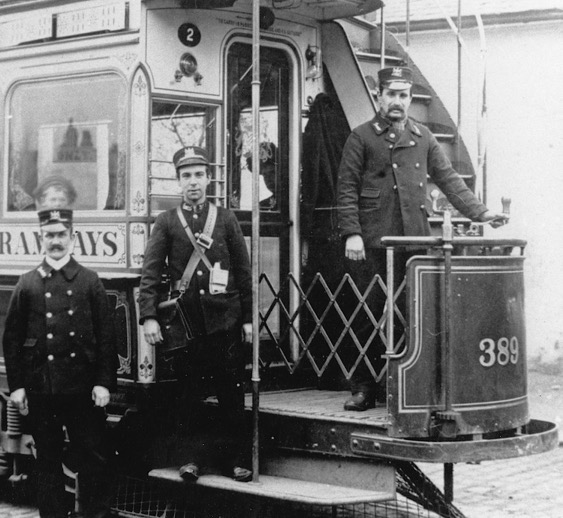
A motorman (called 'Drivers' in Manchester), a conductor (called 'Guards') and another motorman, pose for the camera with Tramcar No 389 on a Longsight to Plymouth Grove service — photo undated, but probably taken in 1902. All those depicted are wearing drooping-peak caps bearing the distinctive Manchester Corporation Tramways cap badge. The difference in the patterns of motormen's and conductors' jackets — double-breasted with fold-over collars versus single-breasted with stand-up collars — are clearly apparent. Author's Collection. 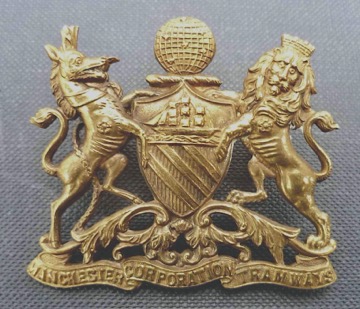
Manchester Corporation Tramways cap badge — brass. Author's Collection.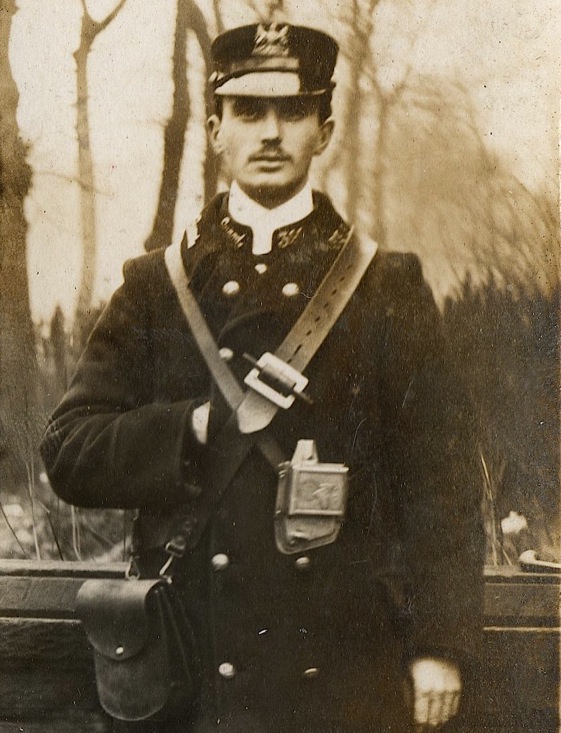
MCT Guard (Employee No 32x) in his greatcoat and drooping-peak cap — photo undated, but almost certainly early Edwardian. His grade badge — on the right-hand collars of his jacket and greatcoat, can just be made out. Author's Collection.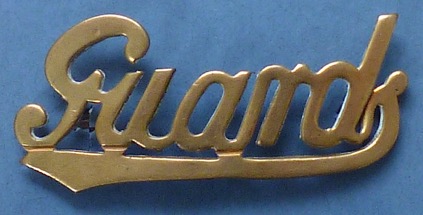
One-piece, underlined grade badge — 'Guard' — of the type used by MCT and two other local systems: the Stalybridge, Hyde, Mossley and Dukinfield Tramways, and possibly by the South Lancashire Tramways Company (for a brief period). Author's Collection.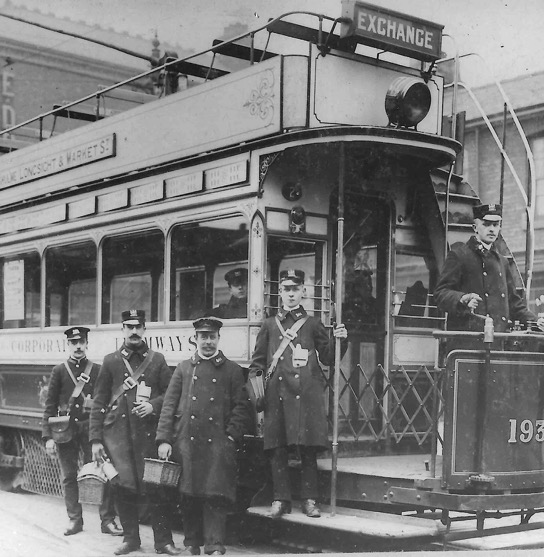
Two tramcar crews (2x motormen, conductors and trolley boys) pose with Brush-built Tramcar No 193 on a Levenshulme to Exchange service via Longsight and Market Street — photo undated, but probably taken in 1902/3. One of the crews has the early drooping-peak caps, whereas the other crew has the soft-topped peaked caps that displaced them. Photograph courtesy of the Stephen Howarth Collection.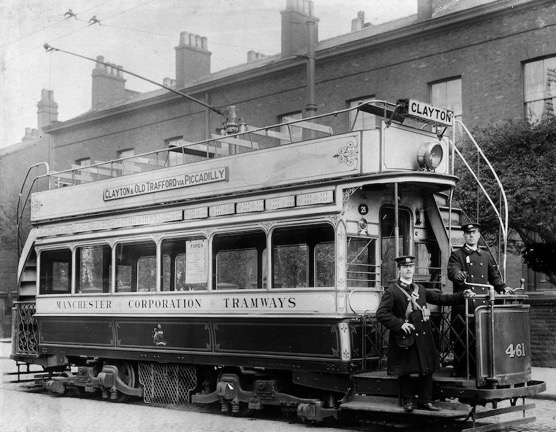
The crew of Tramcar No 461 pose with their charge on a Clayton to Piccadilly service — photo undated, but probably taken around 1904. Photo courtesy of the Duncan Holden Collection.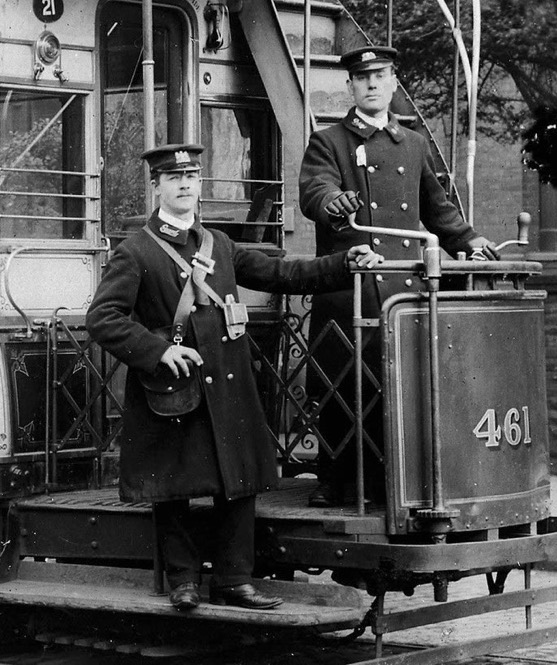
An enlargement of the above photo showing the conductor and motorman. By this time the drooping-peak caps had clearly been displaced by a soft-topped peaked caps. The heavy, double-breasted greatcoats were no doubt essential attire for working on an unenclosed tramcar in a Manchester winter. 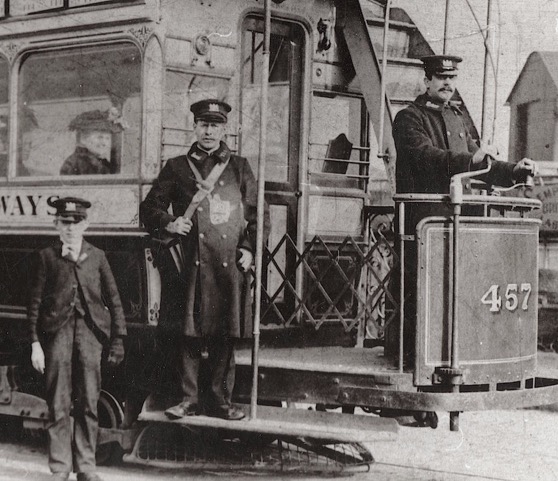
A trolley boy, a conductor and a motorman with Tramcar No 457 on an Ashton to Piccadilly service — photo undated, but probably taken around 1905/6. All those depicted are wearing soft-topped peaked caps rather than the earlier drooping-peak caps. The trolley boy is wearing a single-breasted jacket with an employee number on his right-hand lapel, but no grade badge. Author's Collection.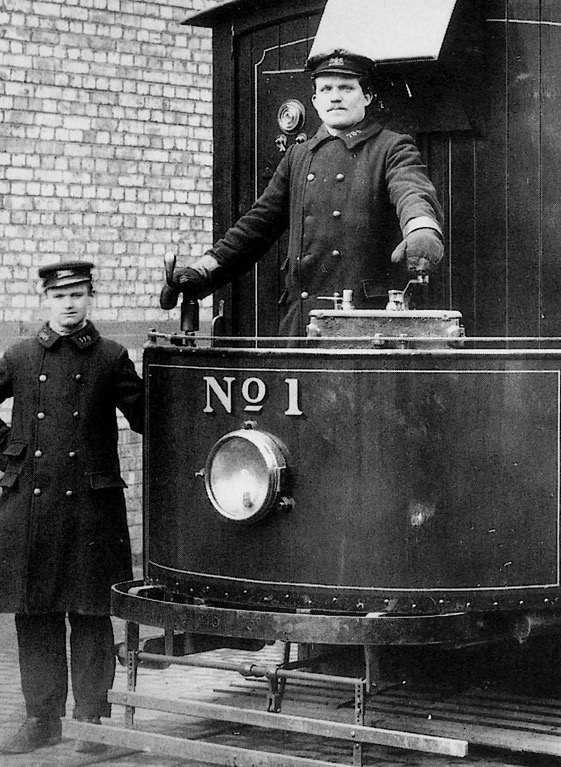
Two Manchester Corporation Tramways Department employees pose with Parcels Car No 1 at Hyde Road Depot — photo undated, but probably mid-Edwardian.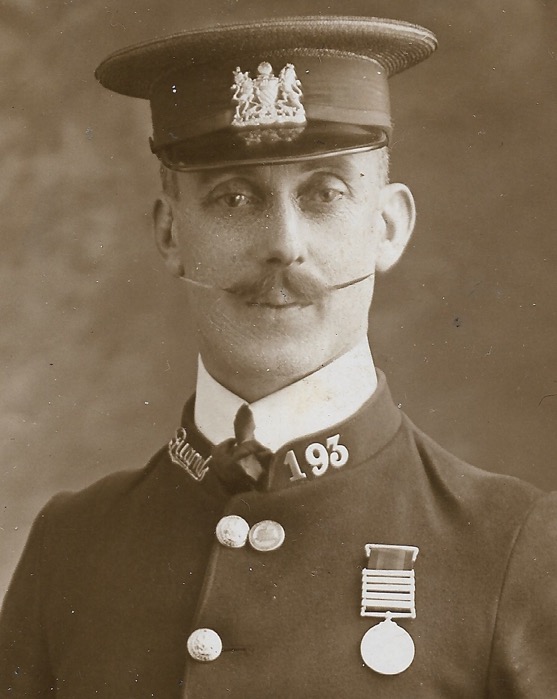
A lovely studio portrait of an MCT guard (conductor), Employee No 193 — photo undated, but probably taken in the mid-Edwardian era given the Queen's South Africa Medal. The badge next to his top tunic button is very probably a union badge. Photo courtesy of the Stephen Howarth Collection.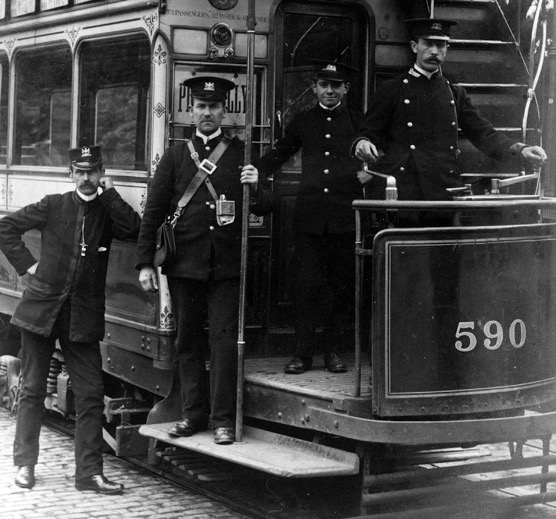
A posed scene aboard the platform of Tramcar No 590 bound for Manchester Exchange — photo dated 'circa 1909'. Left to right are an inspector, a conductor, a trolley boy and a motorman. Trolley boys were seen as an essential part of the crew for larger trams, both in Manchester and in Salford. By this time, the soft-topped peaked caps had been replaced by a smarter design with a tensioned crown (top), though the inspector is still wearing the older style of drooping-peak cap. Image kindly supplied by Beamish Museum Limited (see link), image copyright Beamish Museum Limited.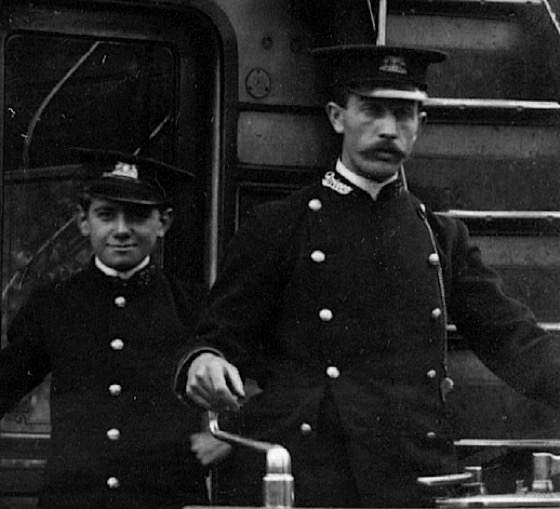
An enlargement of the above photograph showing the trolley boy and the motorman — the cap and collar badges are easily made out.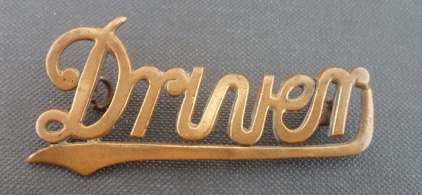
One-piece, underlined grade badge — 'Driver' — brass, of the type possibly used by MCT, though the attribution is not nearly as good as the 'Guard' badge pictured above. Author's Collection.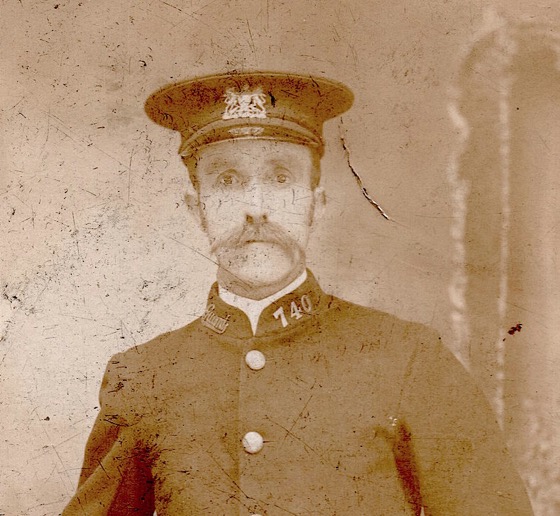
An MCT conductor, Employee No 740, in the new style of peaked cap with a tensioned crown (top) — photo undated, but probably mid-to-late Edwardian era. Photo courtesy of the Richard Rosa Collection.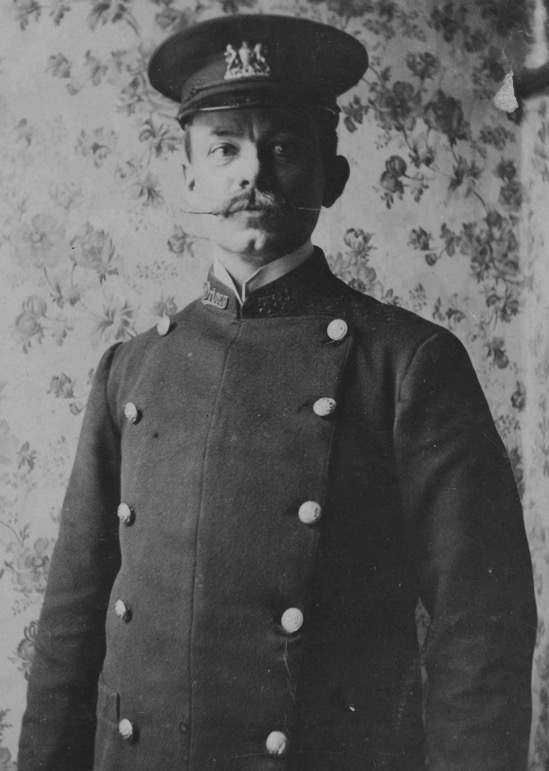
An indoor-shot of a Manchester Corporation Tramways motorman (No 58x?) – photo undated, though judging by the moustache, probably Edwardian. The rear of the photograph is marked 'Joe Grace' in pencil, presumably the subject. Author's Collection.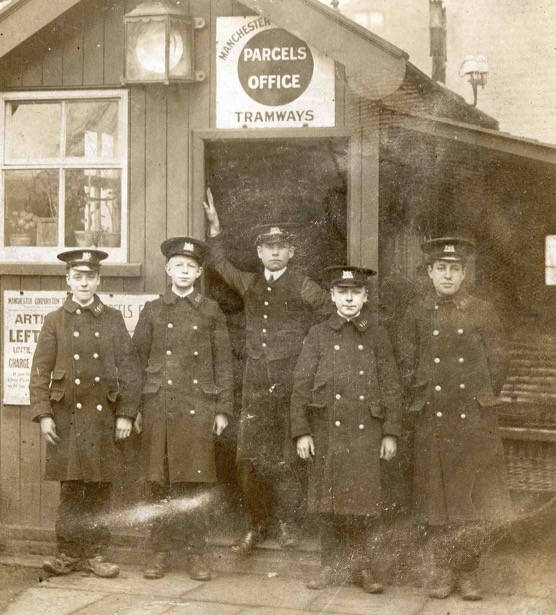
A group of parcels boys, some in clogs, pose outside one of the MCT parcels offices — photo undated, but possibly Edwardian. Photo reproduced with the kind permission of the Greater Manchester Transport Society (see link).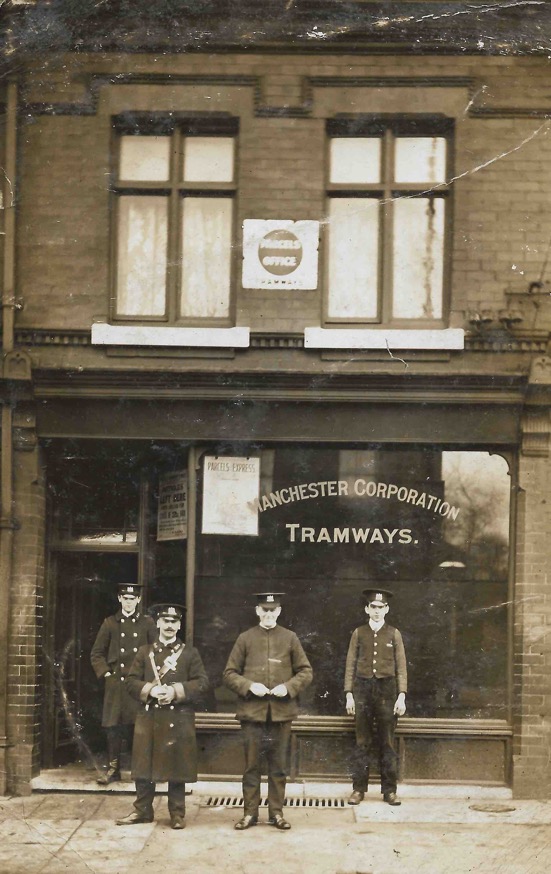
Two parcels boys (left and right), a conductor and an inspector pose for the cameraman outside an unidentified MCT Parcels Office — photo undated, but probably taken around 1910. Photo courtesy of the Stephen Howarth Collection.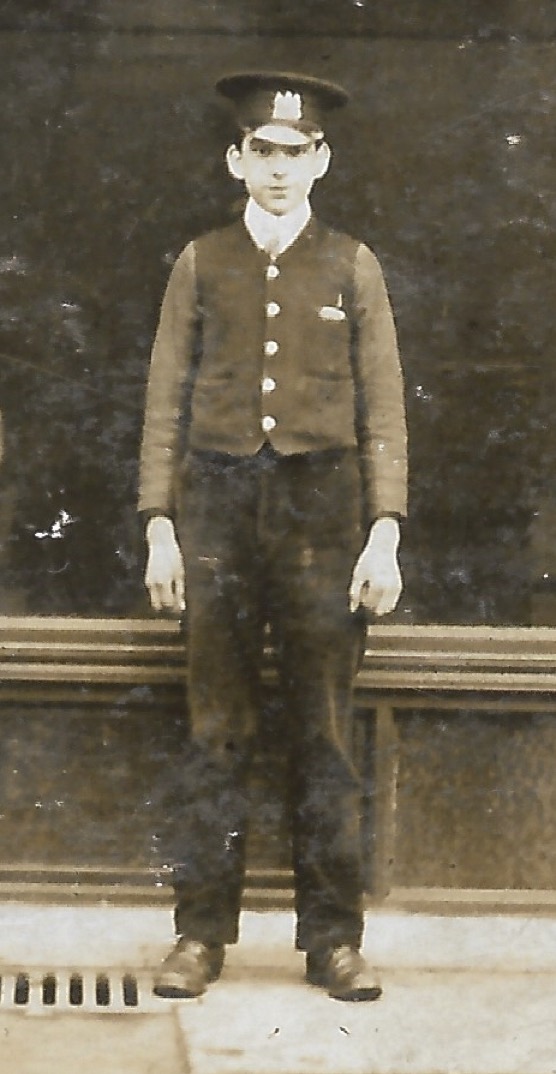
An enlargement of the above photograph showing the parcels boy in his long-sleeved waistcoat.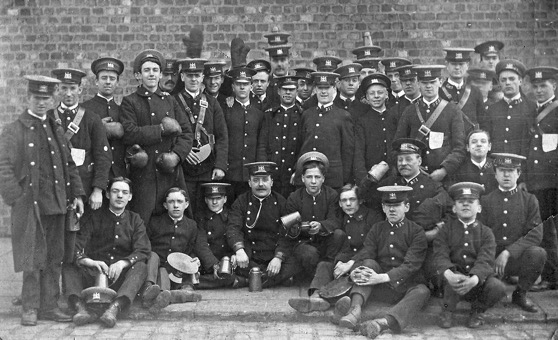
An informal shot of a group of tramcar staff, mostly conductors and trolley boys, and a single motorman (sitting, in lancer-style tunic) — photo undated, but as none of them have epaulettes on their garments, almost certainly taken before the Great War. The trolley boys have employee numbers on their left-hand collars, with the right-hand collar left plain. Photo courtesy of the Duncan Holden Collection.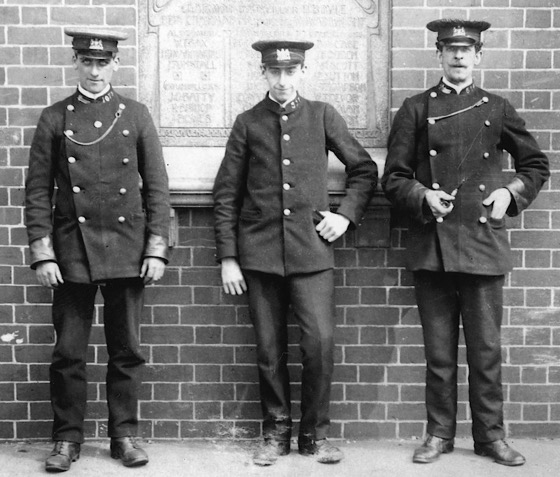
Two motormen (left and right) and a trolley boy (centre), pictured at Queens Road depot — photo undated, but possibly taken shortly before the Great War. Author's Collection.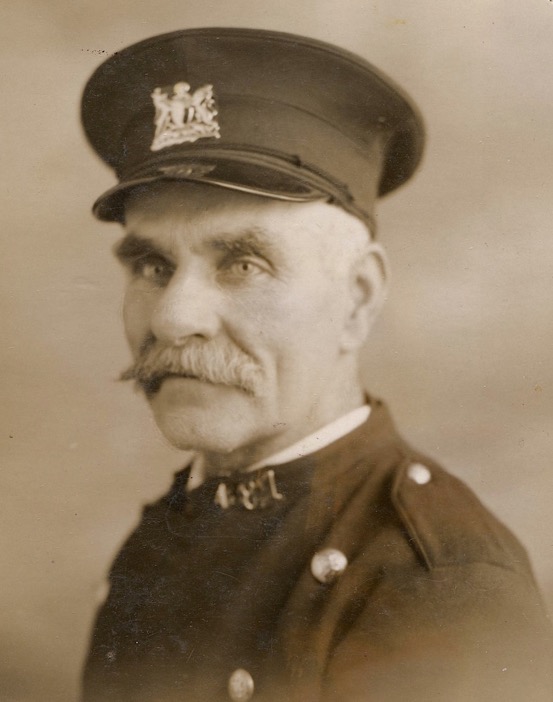
Manchester Corporation Tramways Employee No 487 (very likely a motorman) — photo undated, but probably around the time of the Great War. The jacket has epaulettes. Author's Collection.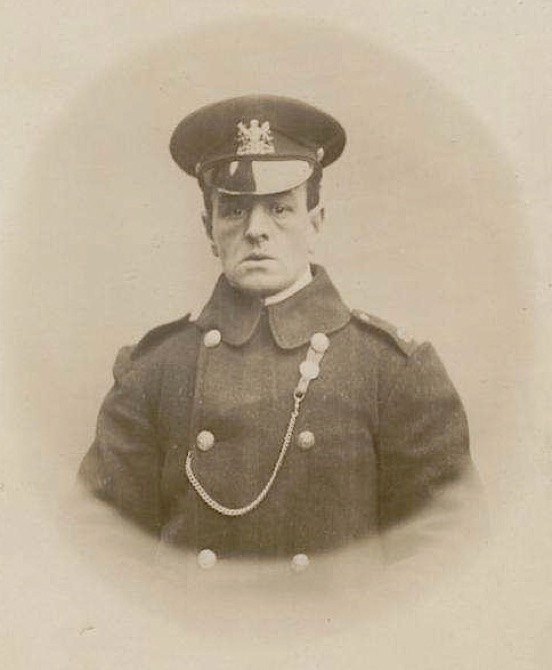
An MCT motorman the later tensioned-crown style of peaked cap, and greatcoat with epaulettes. Photo courtesy of the Stephen Howarth Collection.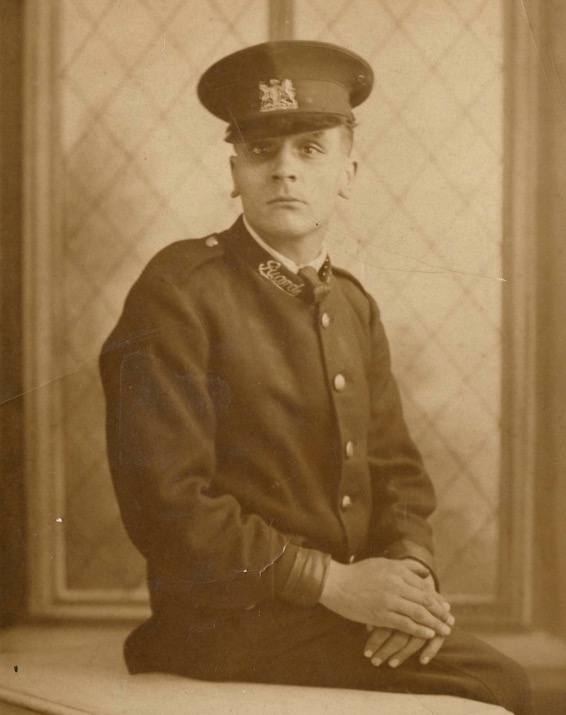
A studio portrait of an MCT conductor — photo undated. Photo reproduced with the kind permission of the Greater Manchester Transport Society (see link).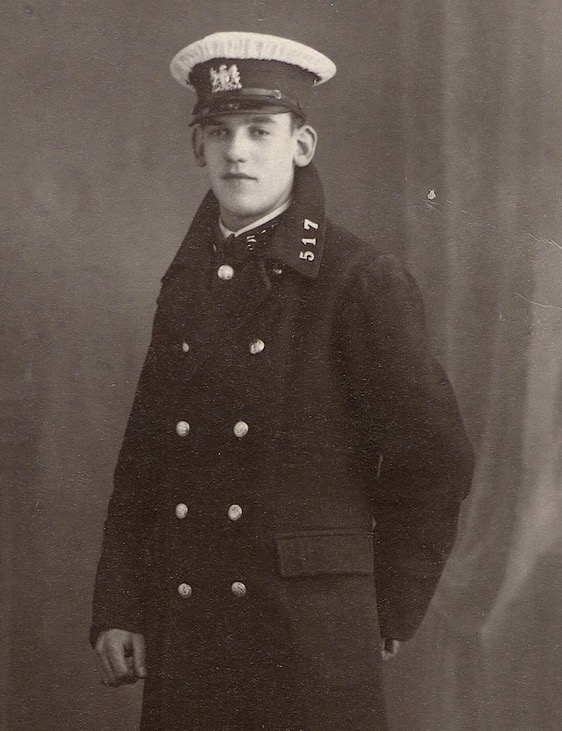
A studio portrait of a Manchester tramwayman, Employee No 517, in a greatcoat — photo undated, but possibly taken in the 1920s. Author's Collection.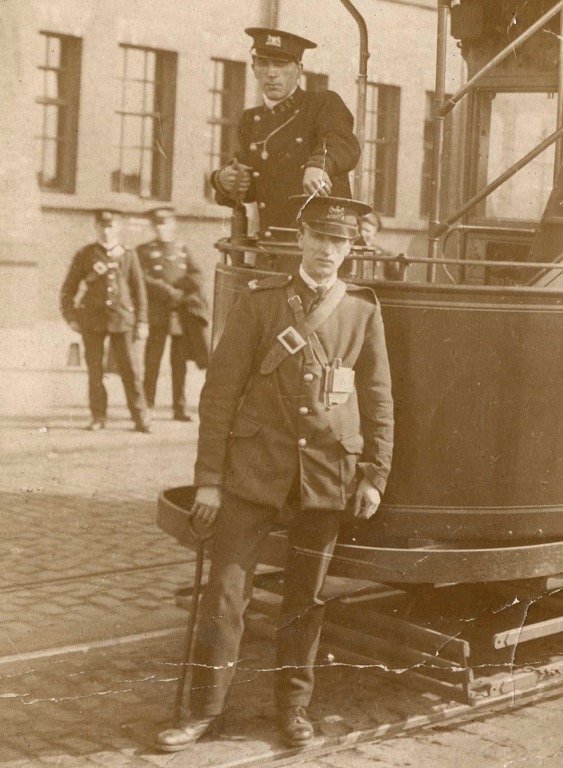
Motorman Jack Hassle and Conductor Jack Palfrey pose with their tramcar at Queens Road Depot circa 1927. The 'Guard' badge is now being worn on the right-hand epaulette rather than the collar. Photo reproduced with the kind permission of the Greater Manchester Transport Society (see link).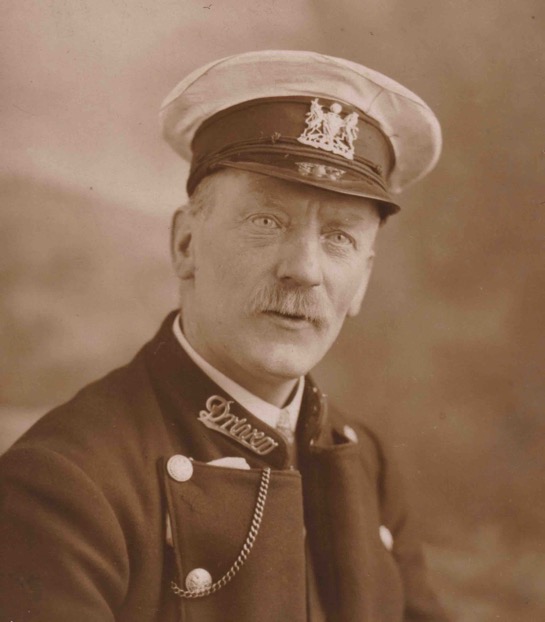
A fine studio portrait of an MCT motorman, which unusually, can be precisely dated to the 15th August 1929. His lancer-style tunic does not have epaulettes. Photo taken in Gales Studios. Author's Collection.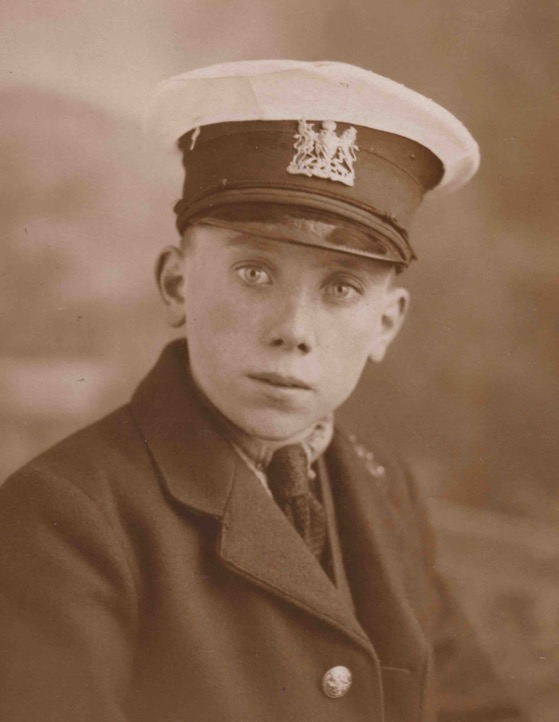
Another fine portrait, taken on the same day as the preceding photograph (15th August 1929) and in the same studios. The subject is possibly a trolley boy or parcels boy. He is wearing a single-breasted jacket with lapels, again with no epaulettes. Both this and the motorman portrait that precedes it ended up in America, so in all likelihood the two individuals were related, and the cards were sent to a relative. Author's Collection.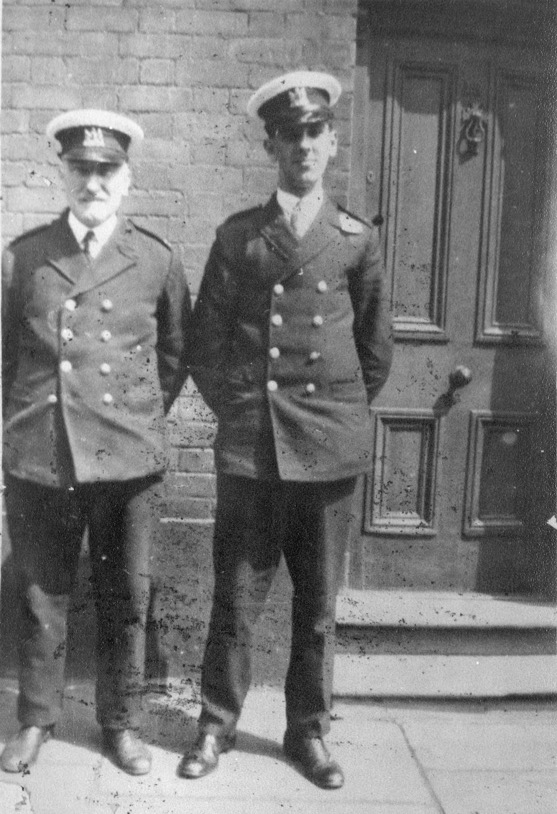
Two tramwaymen pose for the camera, presumably outside one of the mens' homes — photo undated, but probably taken in the late 1930s or early 1940s. Note the more modern double-breasted style of jacket. Photo reproduced with the kind permission of the Greater Manchester Transport Society (see link).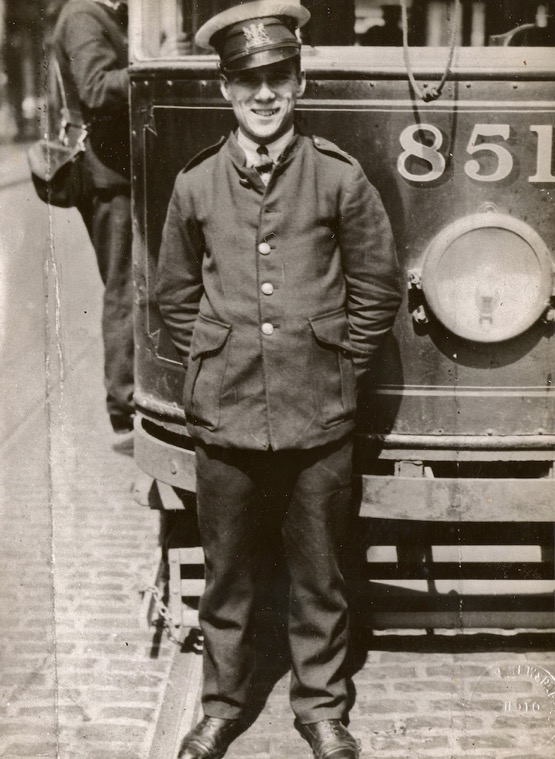
A trolley boy with Tramcar No 851 — purportedly taken on the last day of their employment, or at least in the last year (1933). Author's Collection.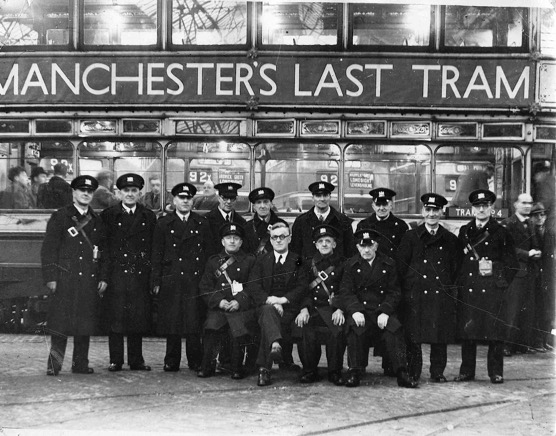
A photograph taken at Birchfields Road Depot on 10th January 1949 to commemorate the last trams run by Manchester. Apart from the manager (seated front) and two inspectors, the five motormen and conductors represent the crews of Tramcars 113, 976, 978 and 1007 (plus the spare, 102). Photo reproduced with the kind permission of the Greater Manchester Transport Society (see link).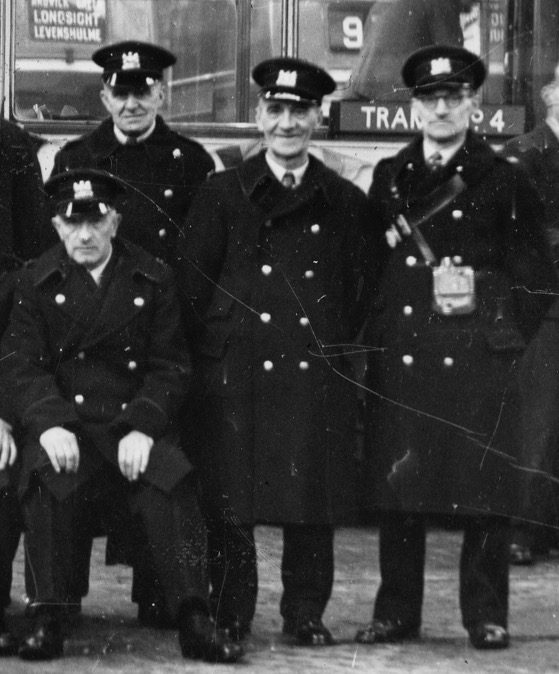
An enlargement of the above photograph, showing the crew of Tramcar 1007, Motorman Richard Berwick (second from right, standing) and Conductor George Cadywould (probably first from the right, standing). Photo reproduced with the kind permission of the Greater Manchester Transport Society (see link).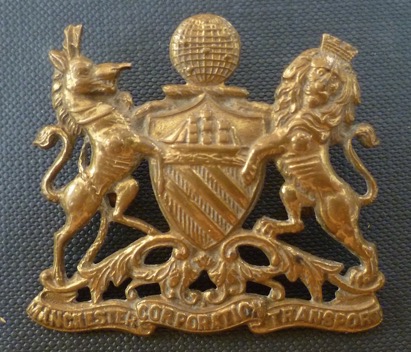
Manchester Corporation Transport cap badge — brass. The name of the department was changed from 'Tramways' to 'Transport' on 1st November 1929, new uniforms issues after this date almost certainly bearing 'Transport' buttons and badges. These were initially brass but would have transitioned to chrome at some point. Author's Collection.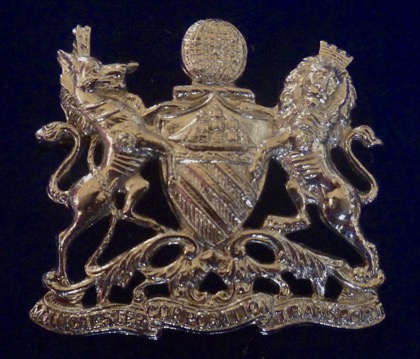
Manchester Corporation Transport cap badge — chrome. Author's Collection.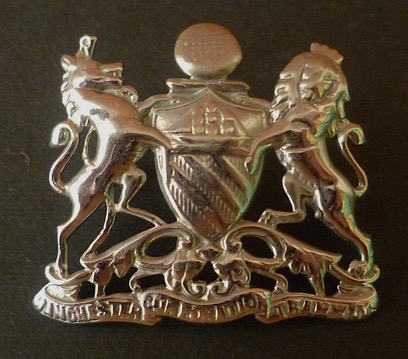
Manchester Corporation Tramways cap badge — chrome-plated nickel. Several examples of this type of badge have survived, one of which came from the MCT Uniform Store at Hyde Road Depot ; the most likely explanation for these is that existing 'Tramways' cap badges were chrome plated on the premises, either at the behest of individuals or because the department chose to re-plate existing badges that it had taken back into stock, many of them clearly showing signs of having been worn prior to chrome plating. Author's Collection.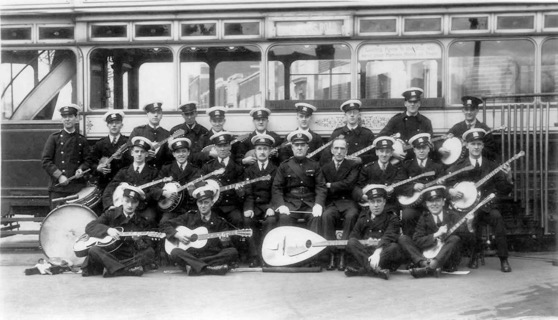
Manchester Corporation Tramways (Transport) Banjo, Guitar and Mandolin Orchestra — photo undated, but probably taken in the 1930's or 1940's. Many tramways, particularly municipally operated concerns, had bands and orchestras, some of which had special 'Tramways Band' cap badges; it is unclear whether Manchester issued such badges, no examples having come to light. Photo courtesy of the Duncan Holden Collection.
Senior staff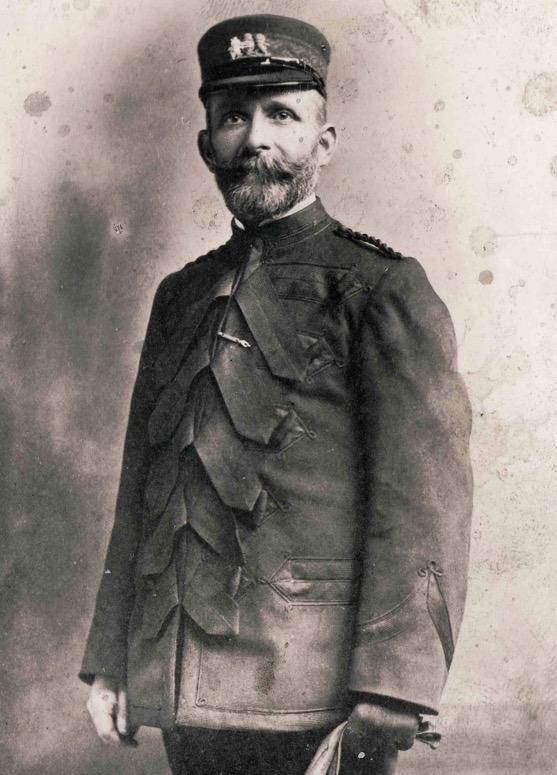
Inspector S E Whillingham circa 1901. Mr Whillingham served with the Manchester Carriage and Tramways Company from 1881 to 1901 and MCT from 1901 to 1907. This rather elaborate style of jacket must have been distinctly impractical as a working garment, and was quickly superseded by a more serviceable style. Photo reproduced with the kind permission of the Greater Manchester Transport Society (see link).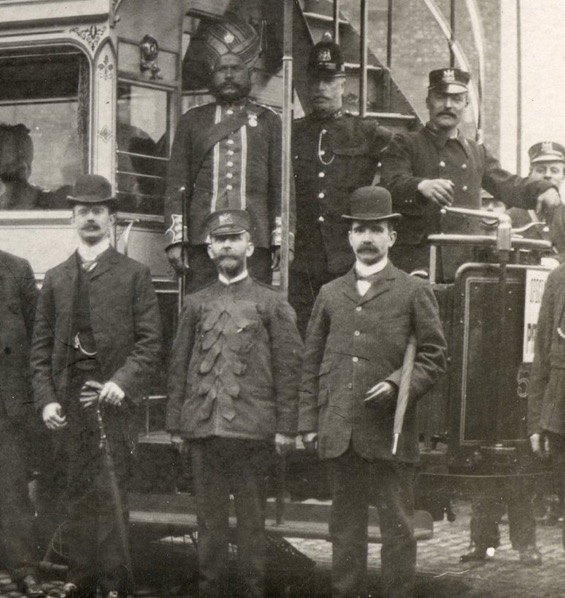
An MCT inspector, together with various dignitaries and a 500-series tramcar, on the occasion of a visit by an Indian military unit — photo undated, but probably taken in 1902 or 1903. Judging by the facial resemblance, the individual depicted may well be Inspector Whillingham. Author's Collection.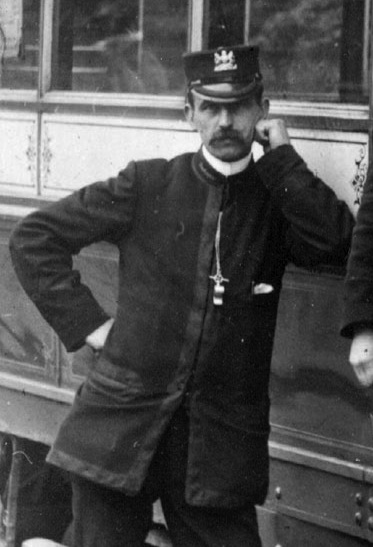
An enlargement of the photograph of Tramcar 590 above, showing the inspector, with embroidered collar designation and whistle.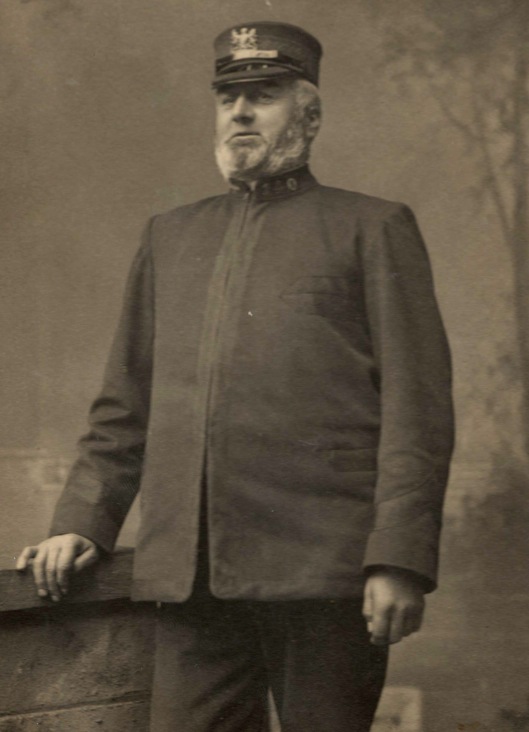
Inspector George William Ross (Employee No 140) of Hulme, who was born in Wigston, Leicestershire, and who died in 1918 aged 65 years — photo undated, but as his grade is given as a Timekeeper in the 1911 census, it was probably taken shortly before the Great War. Photo reproduced with the kind permission of the Greater Manchester Transport Society (see link).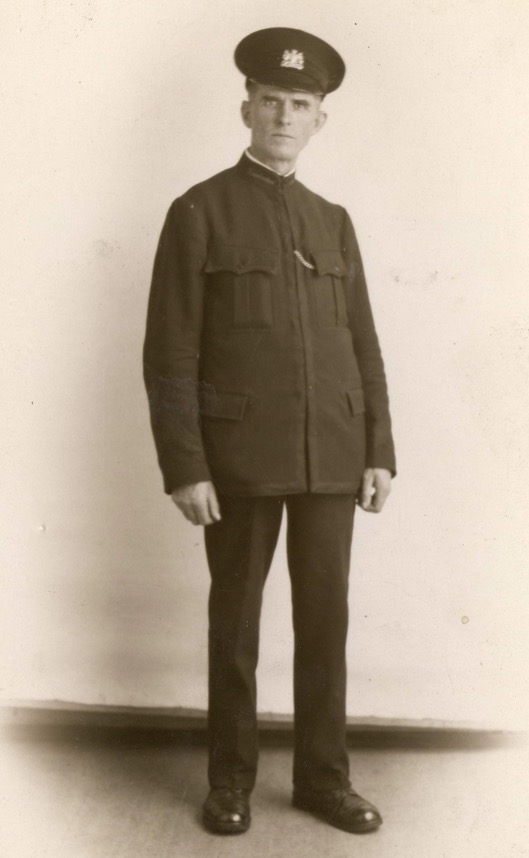
A rather earnest looking Inspector Patrick Feeney of Rusholme — photo undated. Photo reproduced with the kind permission of the Greater Manchester Transport Society (see link).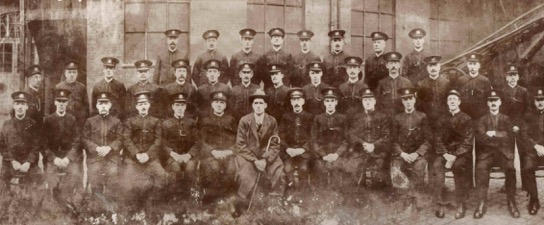
A formal staff photograph of 35 inspectors and a Mr Raw (seated centre, without uniform) — photo undated. Photo reproduced with the kind permission of the Greater Manchester Transport Society (see link).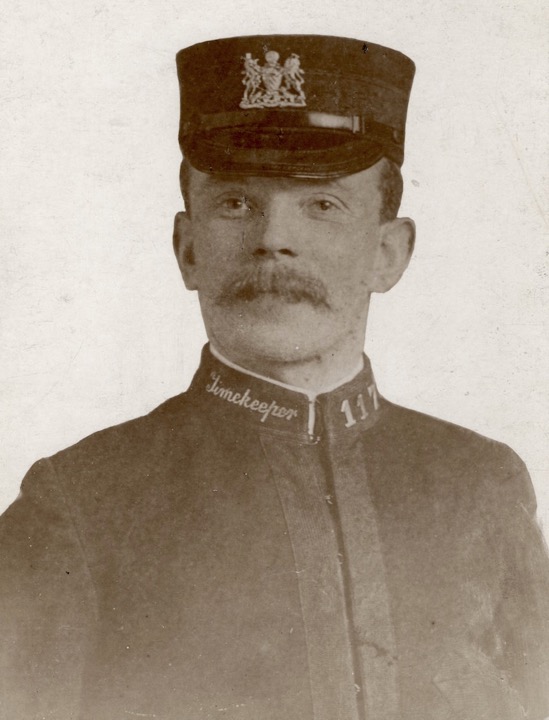
Manchester Corporation Tramways timekeeper, Employee No 117. The photograph is of sufficient quality to discern the 'hook and eye' jacket fasteners, as well as the edging material, which appears to be a form of corduroy, a fabric commonly known as 'Manchester' in continental Europe. Author's Collection.
Female staff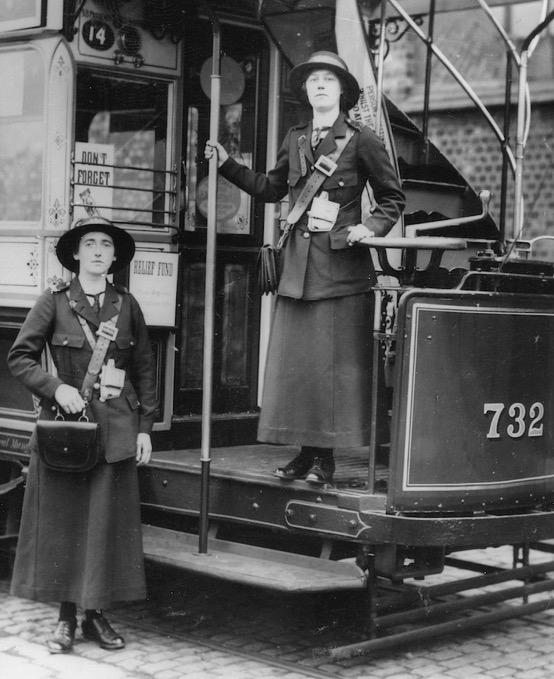
A photo which purportedly depicts Manchester's first two Great War conductresses, along with Tramcar No 732. Both ladies are wearing long skirts, tailored single-breasted jackets and felt bonnets. Author's Collection.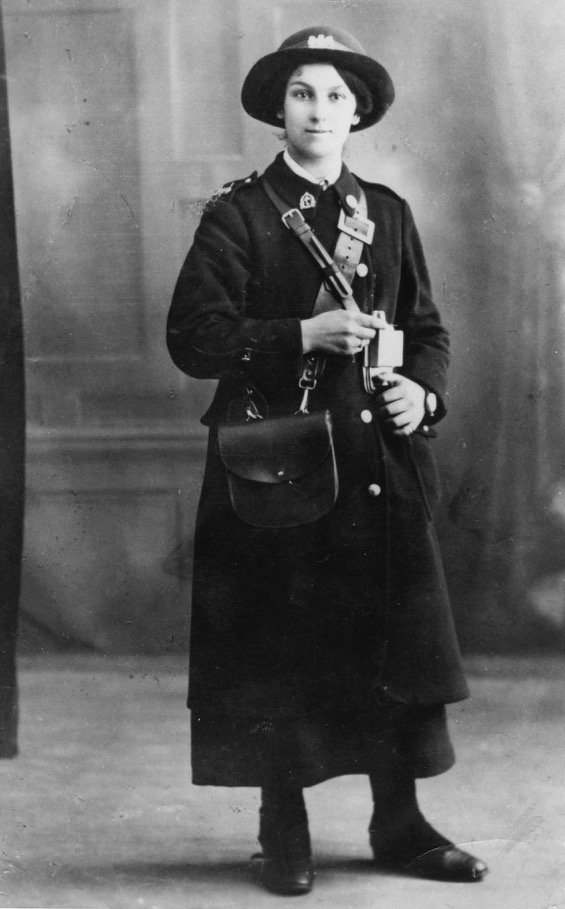
A studio portrait of an unknown MCT conductress — photo undated, but certainly taken during the Great War. She is wearing a 'Guard' badge on her right epaulette and a standard Manchester Corporation Tramways cap badge on her hat band. The small badge on her right-hand collar is probably a sweetheart badge, the wearing of which was very common during the war years. Photo reproduced with the kind permission of the Greater Manchester Transport Society (see link).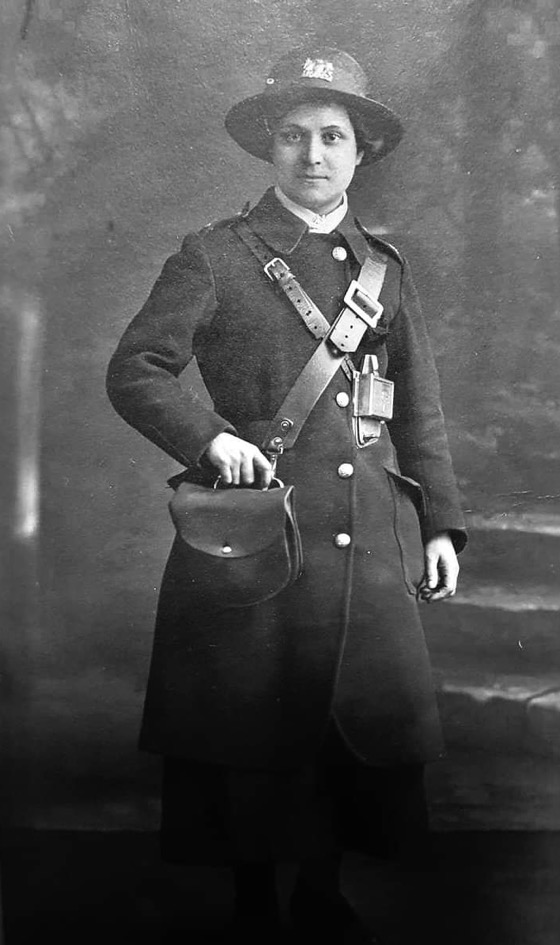
Great War MCT Conductress Mary Ann Bennett (nee Gale), who was born in 1886 in Salford, so she would have been around 30 years old when the photograph was taken. She was married in 1905, and lived another seventy years, dying in 1975. In the photograph, she is wearing a long topcoat with off-centre buttons, and a dark-coloured straw bonnet bearing the standard MCT cap badge. Photo courtesy of Mary Ann's Great Grand Daughter, Stephanie Yewdale.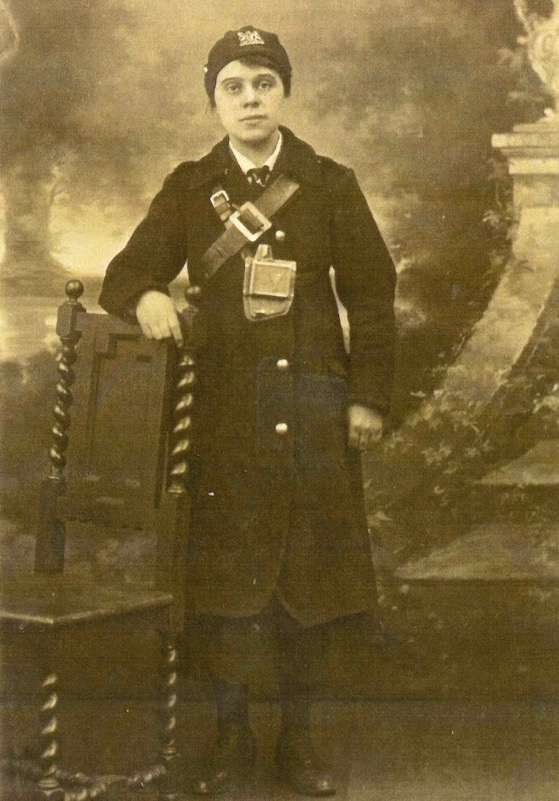
Conductress Millicent Jones (nee Bullock) — photo undated, but certainly taken during the Great War. The brimless bonnet is quite unusual for the period, being more akin to a modern 'beanie'. Photo reproduced with the kind permission of the Greater Manchester Transport Society (see link).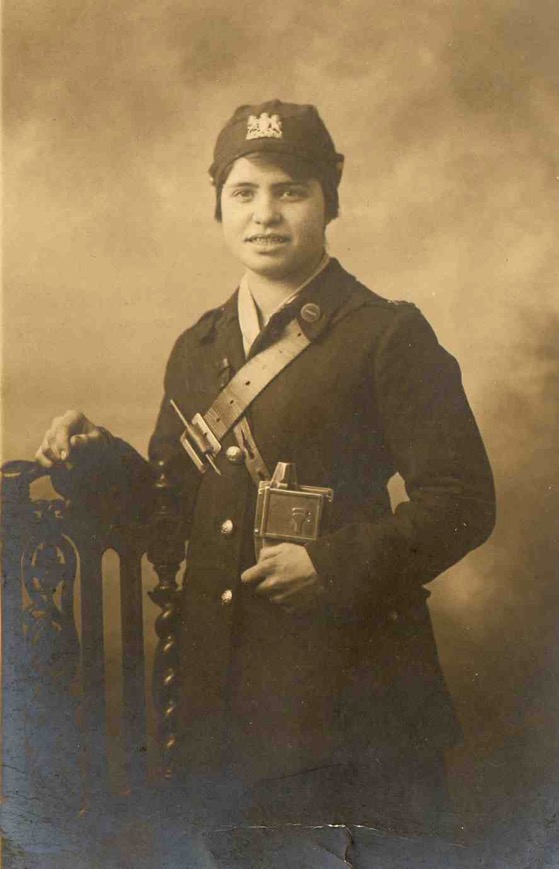
A studio portrait of an unknown MCT Great War conductress, again in a brimless bonnet. With thanks to Nick Thurlow.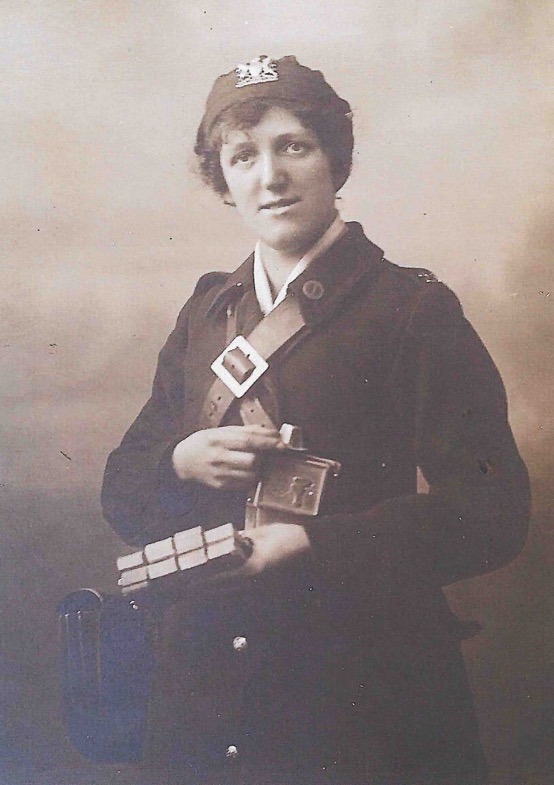
A studio portrait of an unidentified Great War MCT tram conductress, once again in a brimless bonnet. Photograph courtesy of the Stephen Howarth Collection.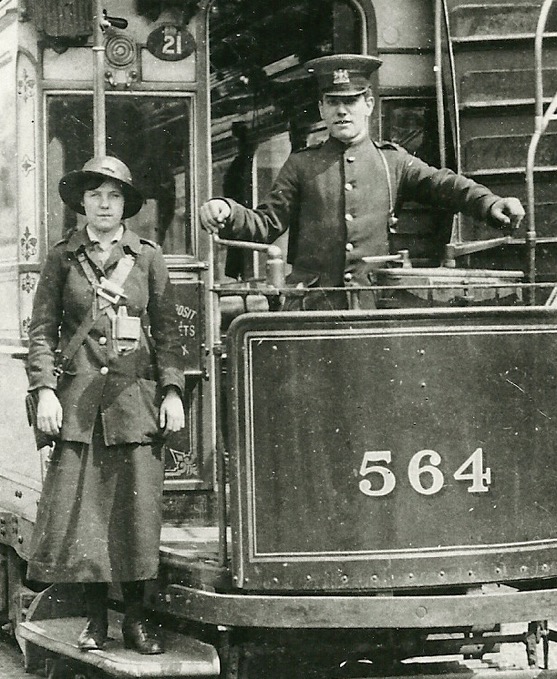
A conductress (guard) and a motorman (driver) on the platform of Tramcar No 564 on Service 18a (Moston Lane-High Street) — photo undated, but almost certainly taken during the Great War. Stephen Howarth Collection.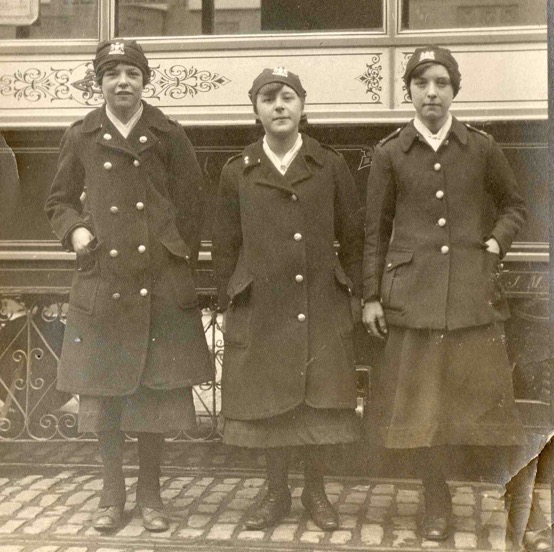
Three female employees, probably trolley girls, pose in their beanie-like hats — photo undated, but clearly taken during the Great War. Photo reproduced with the kind permission of the Greater Manchester Transport Society (see link).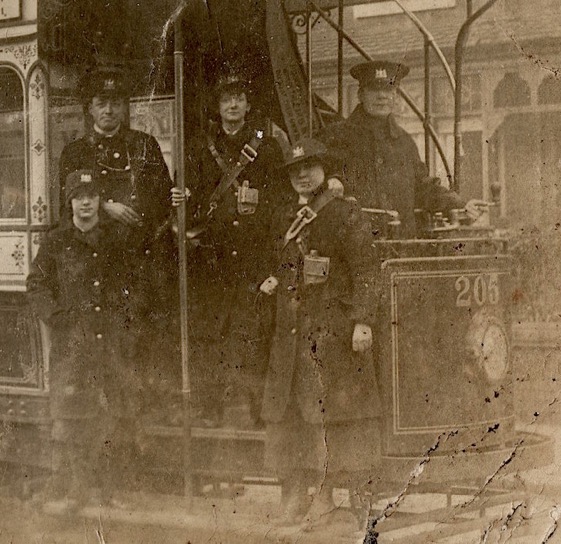
Two motormen, two conductresses and a trolley girl (probably) with Tramcar No 205 on a No 46 service (Piccadilly, Chorlton, Southern Cemetery & Palatine Road) — photo undated, but almost certainly taken during the Great War. Author's Collection.
Tramcar No 657 on a No 53 service (Cheetham Hill road to Brooks Bar) with. from left to right, a trolley boy, a conductress and a motorman — photo undated, but certainly taken during the Great War.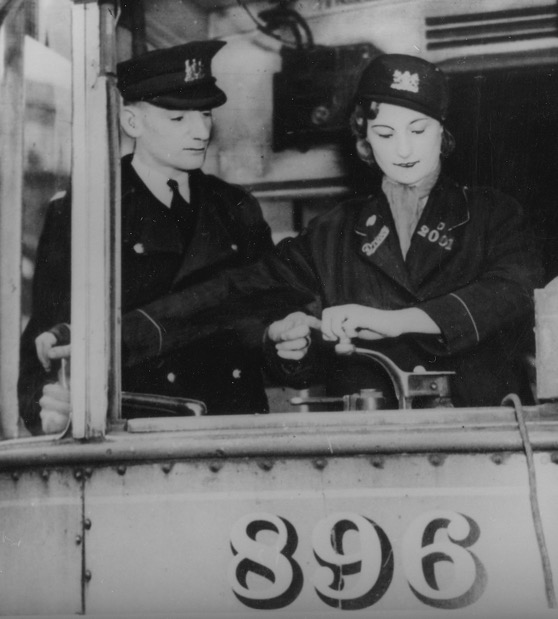
Instructor Jim Botterill with trainee motorwoman (Employee No 2001) aboard Tramcar No 896— photo undated, but almost certainly taken during the Second World War. Author's Collection.